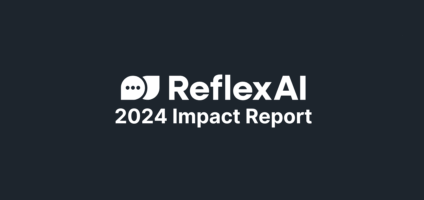Realizing the limitations of traditional call center tech
When Sam and I worked together at The Trevor Project, the leading organization focused on LGBTQ youth suicide prevention, we continually sought new technologies that could improve the quality of our services and the experience of our team. We were often confronted with a frustrating reality: traditional call center technology lacked functionality that would provide a fantastic solution for the crisis continuum.
Most acutely, we saw this lack of fit in two areas: training and quality assurance. Within training, we found an abundance of LMS platforms but no tools that could provide the real-world practice our trainees deserved. Existing tools provided the ability to review content and respond to specific prompts but not to practice the full interaction that dynamically utilized skills such as empathy and risk assessment. Within quality assurance, we found tools built for customer service or sales interactions. They measure the time an agent spends per call, close rate, and most frustratingly (for crisis) on semantic measurement, which does not consider complex emotions.
We wanted tools that reflected the nuances of the crisis world, where it was possible to practice (in training) and analyze (in QA) how team members were performing on high priority areas such as asking open-ended questions, exhibiting empathy, conducting a clinically-validated risk assessment, and engaging in appropriate safety planning. Existing tools didn’t meet these high priority needs. And they certainly did not meet them to the standard that we felt our teams deserved. In response, we first developed the Crisis Contact Simulator for use within The Trevor Project. Two years later, we launched ReflexAI to bring an even wider set of tools to organizations across the crisis space. Here are a few reflections from this work.
Why technology is essential in crisis lines
While crisis lines and traditional contact centers may have many similarities, they differ in pretty significant ways. Crisis centers by definition handle situations that require empathy and precision—responders need to be trained on (among many others things) how to de-escalate, provide validation, and take appropriate action in sensitive situations.
With the national launch of 988 and a rapidly increasing volume of contacts, crisis centers are being asked to do more. They need systems that can help manage this influx of calls, texts, and chats in an efficient, human-centered way. Training responders properly—whether they are seasoned staff, newcomers, and volunteers—is critical. So is giving them access to quality assurance that reflects real-world scenarios, not just traditional customer service metrics.
For far too long, technology in the crisis space has been seen as secondary—either too expensive, too niche, or too hard to customize. We disagree. Technology should allow crisis centers to focus on the real mission: helping people when they are most vulnerable, not trying to adjust tools that weren’t built for them.
We built ReflexAI to solve these problems
When Sam and I launched ReflexAI, we knew that we wanted to build a solution that addressed all these gaps. We did not want our partners to “make do” with tools built for other industries—we wanted to build something from the ground up that understands the nuances of crisis intervention.
Among our priorities, we focused on:
Deep, roleplay-based training
Our AI-powered roleplay simulations allow responders to practice their skills in hyper-realistic scenarios. ReflexAI is built to help responders of all experience levels improve and ensure they ask open-ended questions, assess risk, express empathy, and de-escalate crisis situations—all through lifelike simulations that can be accessed anywhere, anytime. Volunteers or part-time staff can train when it’s convenient for them, without the pressure of full-time onboarding that could make crisis work inaccessible.
Functionality to simplify operations
The teams that manage crisis services programs – including trainers, QA specialists, supervisors, clinical directors, and so many more – often use a wide range of tools to keep track of operations. This can include spreadsheets, complicated formulas to calculate core statistics, and even handwritten notes. Within ReflexAI tools, we’ve built an intuitive system for cohort management with easy-to-tailor dashboards that replace those workarounds.
Tailored workflow features
Many processes are happening every day within a crisis organization, so there is a daily opportunity to improve the team’s experience. For example, within quality assurance, we know the importance of case reviews to provide feedback and ensure quality. ReflexAI tools include intuitive review workflows so members of the team can easily identify which cases have been marked for review and which ones have been reviewed already.
The right approach to security and data
When we used to look for crisis technology at Trevor, it was clear that we would need to navigate complex settings to ensure our data was secured. At ReflexAI, we decided to do things differently. The short summary is that we approach all questions about security and data through the mindset of, “How would we want to protect this data if it contained information about a member of our family?” From that foundation, we developed tools like realistic simulations which require no data from actual calls, and QA tools that include best in class scrubbers for PII/PHI before any data is analyzed by ReflexAI models.
Meaningful quality assurance
Instead of focusing on semantic measurements like tone, ReflexAI’s QA tool Assure focuses on what matters most in crisis calls: Did the responder ask the right risk assessment questions, and do so using best-practice language? Did they listen actively? Were they deeply empathetic? By analyzing the actual language used during an interaction, ReflexAI’s QA system provides feedback based on crisis line best practices, not just the semantics of the call.
Scalable for high-volume centers
Crisis centers today must handle an increasing number of contacts, and numbers are projected to increase in the years ahead. ReflexAI helps these organizations by offering tools that scale. Our platform can assess 100% of interactions—not only the small percentage typically reviewed—giving organizations the full picture of their performance and training needs.
Mission-driven technology
Every feature we’ve built in ReflexAI is designed to support the mission of crisis centers. Whether it’s a focus on accessibility, flexible deployment, or ethical AI, ReflexAI is not just a technology platform—it’s a partner to organizations that are committed to providing life-saving support.
A final perspective
When we started ReflexAI, we knew the industry’s high aspirations were not being met by the tools at their disposal. Too many crisis centers were relying on technology that didn’t reflect their needs. By building ReflexAI, we aim to provide technology that makes a difference—supporting responders, improving training, and ultimately helping more people in need.
The reality is, crisis lines need tools as responsive and human-centered as their teams. And that’s exactly what ReflexAI offers.






